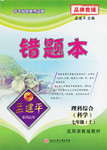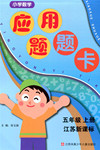题目内容
Most of what has been said about the Smiths also ____true of the Johnsons.(2006年安徽高考)
A.are B.is C.being D.to be
B
解析:
B考查主谓一致。分析句式找准主语most of what-----指说的内容,为不可数故答案为B,构成系表结构。

 孟建平错题本系列答案
孟建平错题本系列答案 超能学典应用题题卡系列答案
超能学典应用题题卡系列答案Communications technologies are far from equal when it comes to conveying the truth.The first study to compare honesty across a range of communication media has found that people are twice as likely to tell lies in phone conversations as they are in emails.The fact that emails are automatically recorded—and can come back to puzzle you---appears to be the key to the finding.
Jeff Hancock of Cornell University in Ithaca, New York, asked 30 students to keep a communications diary for a week.In it they noted the number of conversations or email exchanges they had lasting more than 10 minutes, and confessed to how many lies they told.Hancock then worked out the number of lies per conversation for each medium.He found that lies made up 14 per cent of emails, 21 percent of instant messages, 27 per cent of face-to-face interactions and an astonishing 37 percent of phone calls.
His results to be presented at the conference on human-computer interaction in Vienna, Austria, in April, have surprised psychologists.Some expected emailers to be the biggest liars, reasoning that because deception makes people uncomfortable, the indirect contact of emailing would make it easier to lie.Others expected people to lie more in face-to-face exchanges because we are most practiced at that form of communication.
But Hancock says it is also crucial whether a conversation is being recorded and could be reread, and whether it occurs in real time.People appear to be afraid to lie when they know the communication could later be used to hold them to account, he says.This is why fewer lies appear in email than on the phone.
People are also more likely to lie in real time---in an instant message or phone call, say---than if they have time to think of a response, says Hancock.He found many lies are spontaneous(脱口而出) responses to an unexpected demand, such as: “Do you like my dress?”
Hancock hopes his research will help companies work out the best ways for their employees to communicate.For instance, the phone might be the best medium for sales where employees are encouraged to stretch the truth.But, given his result, work assessment where honesty is a priority, might be best done using email.
【小题1】Hancock’s study focuses on _______.
| A.the consequences of lying in various communications media |
| B.the success of communications technologies in conveying ideas |
| C.people are less likely to lie in instant messages |
| D.people’s honesty levels across a range of communications media |
| A.people are less likely to lie instant messages |
| B.people are unlikely to lie in face-to-face interactions |
| C.people are most likely to lie in email communication |
| D.people are twice as likely to lie in phone conversations |
| A.They are afraid of leaving behind traces of their lies |
| B.They believe that honesty is the best policy |
| C.They tend to be relaxed wh en using those media |
| D.They are most practised at those forms of communication |
| A.honesty should be encouraged in interpersonal communications |
| B.suitable media should be chosen for different communication purposes |
| C.more employers will use emails to communicate with their employees |
| D.email is now the dominant medium of communication within a company |
This site contains 100 original short stories about life in America. These stories are written for ESL(English as a second language ) learners who are, at least, high beginners. We want to help ESL students learn English as quickly and effortlessly as possible. Learning should be interesting, not boring. We hope that learners will find that these stories are of some help to improve their English.
The stories have interesting topics and are easy to understand. Each story comes with an audio narrative so that learners can listen as they read. The audio requires downloading the free Real Player. Each story contains a search for pictures, definitions, and pronunciation.“ Following each story are four sets of exercises, and each containing 10 items.
Exercise A is “Yes / No Questions”. The learner is asked questions like, “Does Sara have children?” The learner can then type in, “Yes, she does.” Then the learner can check whether it’s the right answer or not.
Exercise B is “Wh-Questions”. The learner is asked questions like, “Where does Sara live?” The learner can then type in, “She lives in Pasadena.” Then the learner can check his answer.
Exercise C is “Ask Questions”. The learner is given an answer like, “They have two children.” The learner must then type in a question like, “How many children do they have?”The learner can then check to see whether he is correct or not. Exercise D is “Dictation”. The learner listens to a sentence. Most of the sentences duplicate the sentences in the stories. The learner types the dictation and then checks to see whether he is correct or not.
Work on the site is in progress. Help us make it better as the years go by. We welcome all comments, suggestions, complaints, new ideas, and questions. Click here to send us emails.
1.Where does this passage come from?
|
A.A newspaper. |
B.A magazine. |
C.A website. |
D.A research report. |
2.The main purpose of this passage is to _____.
|
A.tell English learners how to do exercises |
|
B.ask the readers to help them improve the site |
|
C.give a brief introduction of an English learning site |
|
D.teach you how to download English articles |
3.All of the following statements are correct EXCEPT _______.
|
A.the learners can listen to a story while reading it |
|
B.there are pictures, definitions, and pronunciation, as well as exercises followed |
|
C.new ideas and suggestions are welcomed |
|
D.the stories are suitable for learners of different levels |
4.If you want to improve your listening ability, you may mainly do some practice in _____.
|
A.Exercise A |
B.Exercise B |
C.Exercise C |
D.Exercise D |
Communications technologies are far from equal when it comes to conveying the truth.The first study to compare honesty across a range of communication media has found that people are twice as likely to tell lies in phone conversations as they are in emails.The fact that emails are automatically recorded—and can come back to puzzle you---appears to be the key to the finding.
Jeff Hancock of Cornell University in Ithaca, New York, asked 30 students to keep a communications diary for a week.In it they noted the number of conversations or email exchanges they had lasting more than 10 minutes, and confessed to how many lies they told.Hancock then worked out the number of lies per conversation for each medium.He found that lies made up 14 per cent of emails, 21 percent of instant messages, 27 per cent of face-to-face interactions and an astonishing 37 percent of phone calls.
His results to be presented at the conference on human-computer interaction in Vienna, Austria, in April, have surprised psychologists.Some expected emailers to be the biggest liars, reasoning that because deception makes people uncomfortable, the indirect contact of emailing would make it easier to lie.Others expected people to lie more in face-to-face exchanges because we are most practiced at that form of communication.
But Hancock says it is also crucial whether a conversation is being recorded and could be reread, and whether it occurs in real time.People appear to be afraid to lie when they know the communication could later be used to hold them to account, he says.This is why fewer lies appear in email than on the phone.
People are also more likely to lie in real time---in an instant message or phone call, say---than if they have time to think of a response, says Hancock.He found many lies are spontaneous(脱口而出) responses to an unexpected demand, such as: “Do you like my dress?”
Hancock hopes his research will help companies work out the best ways for their employees to communicate.For instance, the phone might be the best medium for sales where employees are encouraged to stretch the truth.But, given his result, work assessment where honesty is a priority, might be best done using email.
1.Hancock’s study focuses on _______.
|
A.the consequences of lying in various communications media |
|
B.the success of communications technologies in conveying ideas |
|
C.people are less likely to lie in instant messages |
|
D.people’s honesty levels across a range of communications media |
2.Hancock’s research finding surprised those who believed that _____.
|
A.people are less likely to lie instant messages |
|
B.people are unlikely to lie in face-to-face interactions |
|
C.people are most likely to lie in email communication |
|
D.people are twice as likely to lie in phone conversations |
3.According to the passage, why are people more likely to tell the truth through certain media of communication?
|
A.They are afraid of leaving behind traces of their lies |
|
B.They believe that honesty is the best policy |
|
C.They tend to be relaxed wh en using those media |
|
D.They are most practised at those forms of communication |
4.It can be inferred from the passage that ________.
|
A.honesty should be encouraged in interpersonal communications |
|
B.suitable media should be chosen for different communication purposes |
|
C.more employers will use emails to communicate with their employees |
|
D.email is now the dominant medium of communication within a company |